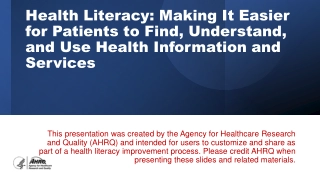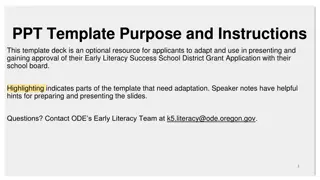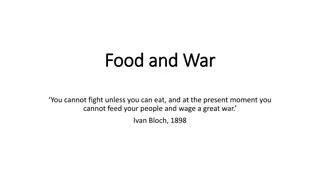Enhancing Learners' Skills in Mathematical Literacy with Food Labelling
Explore how food labelling can improve mathematical literacy skills in learners, focusing on understanding nutrition labels, energy values, and daily intake recommendations. The questions presented delve into interpreting food labels, understanding calorie values, and the importance of nutritional information per 100 grams for making informed food choices.
Download Presentation
Please find below an Image/Link to download the presentation.
The content on the website is provided AS IS for your information and personal use only. It may not be sold, licensed, or shared on other websites without obtaining consent from the author. Download presentation by click this link. If you encounter any issues during the download, it is possible that the publisher has removed the file from their server.
Presentation Transcript
Wales in a global context: enhancing learners skills Mathematical literacy: Food labelling
Food labelling: Introduction This question is from the domains of science and mathematics and tests both domain specific knowledge and inference skills. Prior skills and knowledge Mathematics The question is suitable for Key Stage 4 learners in both a formative and summative manner. Express one quantity as a percentage of another Convert between metric units of weight Know and use prefixes of metric measurements Be able to use an algebraic formula Be able to substitute numbers into an algebraic formula Be able to round numbers to the nearest whole number Interpret tables, identify and select the most appropriate information Some prior knowledge is assumed, which is detailed in the panel on the right-hand side of this page. Answers and commentary is given in the notes section of this presentation. Estimated level: ***
Food labelling Food labelling: Question 1 The laws around nutrition labelling in the UK outline what information must be provided to you, as a consumer, when buying food, and how that information must be presented. 1 Checking the nutrition label is a good way to make healthier food choices. Nutrition labels can help you choose between products and track the amount of different ingredients you're eating. Refer to Food labelling on the right. 5 Read lines 1 6 and answer the following question. Food labels These labels include information on energy in kilojoules (kJ) and kilocalories (kcal), usually referred to as calories. They also include information on fat, saturates (saturated fat), carbohydrate, sugars, protein and salt. Find and copy two reasons why it may be important to read food labels. 10 Food data All nutrition information is provided per 100 grams and sometimes per portion of the food. This information appears as the number of grams (g) and as a share (%) of your Reference Intake (RI) or daily allowance. 15 The RI on a front of pack label is based on the requirements for an average person. The average woman needs 2,000 calories per day, the average man 2,500 calories and children fewer than 2,000 calories, depending on their age. 20
Food labelling Food labelling: Question 2 1 The laws around nutrition labelling in the UK outline what information must be provided to you, as a consumer, when buying food, and how that information must be presented. Checking the nutrition label is a good way to make healthier food choices. Nutrition labels can help you choose between products and track the amount of different ingredients you're eating. Refer to Food labelling on the right. 5 Line 13 states that nutritional information is provided per 100 grams . Food labels These labels include information on energy in kilojoules (kJ) and kilocalories (kcal), usually referred to as calories. They also include information on fat, saturates (saturated fat), carbohydrate, sugars, protein and salt. Explain why this is an important aspect of food labelling. 10 Write your reasons in the box below. Food data All nutrition information is provided per 100 grams and sometimes per portion of the food. This information appears as the number of grams (g) and as a share (%) of your Reference Intake (RI) or daily allowance. 15 The RI on a front of pack label is based on the requirements for an average person. The average woman needs 2,000 calories per day, the average man 2,500 calories and children fewer than 2,000 calories, depending on their age. 20
Food labelling Food labelling: Question 3 The laws around nutrition labelling in the UK outline what information must be provided to you, as a consumer, when buying food, and how that information must be presented. 1 Checking the nutrition label is a good way to make healthier food choices. Nutrition labels can help you choose between products and track the amount of different ingredients you re eating. Refer to Food labelling on the right. 5 Read lines 7 20 and answer the following questions. a) What number does the prefix kilo represent in the decimal system? Food labels These labels include information on energy in kilojoules (kJ) and kilocalories (kcal), usually referred to as calories. They also include information on fat, saturates (saturated fat), carbohydrate, sugars, protein and salt. 10 b) Write 100 grams in units of kilograms. Food data All nutrition information is provided per 100 grams and sometimes per portion of the food. This information appears as the number of grams (g) and as a share (%) of your Reference Intake (RI) or daily allowance. c) How much more calories does an average man need compared to an average woman? 15 The RI on a front of pack label is based on the requirements for an average person. The average woman needs 2,000 calories per day, the average man 2,500 calories and children fewer than 2,000 calories, depending on their age. d) Write your answer to part C as a percentage of the average woman s calories. 20
Food labelling Food labelling: Question 4 1 Reference Intakes The term Reference Intakes (RI) has replaced Guideline Daily Amounts ( GDAs ). RIs are written as a percentage of the food portion on food labels. Nutrition label Reference Intakes (RI) per portion (Daily) The Reference Intakes (RI) are written on food labels as percentages. These are calculated using the Reference Intakes (RI) per portion (Daily) guidance in the table on the right. Energy 8400kJ To calculate the percentage of the RI use the following two-step process: Energy 2000kcal Fat 70g ?????? ?? ???????? ??? ??????? ?? ???????? ????? ???? ????? (i) 100 = ??% Saturates 20g Sugars 90g (ii) Round the RI% value to the nearest whole number. Salt 6g Calculate the RI percentage of each of the nutrients for the grilled burger food item. Food item Each grilled burger (94g) contains 5 Typical values (as sold) per 100g: Energy 966 KJ / 230 kcal
Food labelling Food labelling: Question 5 1 Traffic light system The table below indicates how the Food Standards Agency requires food manufacturers to be compliant with food labelling on their products. Read the Traffic light system section on the right. Use the traffic light system and the information supplied in Question 4 to answer the following question. 5 This traffic light system has to be shown on all food products. What colours would each nutrient of the grilled burger receive?

















































